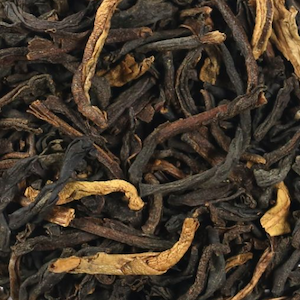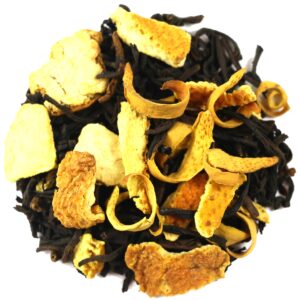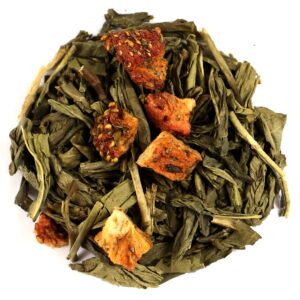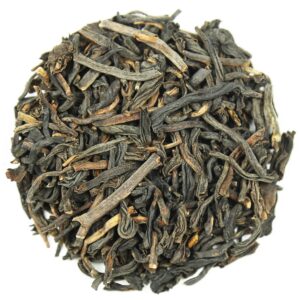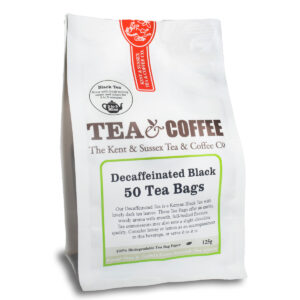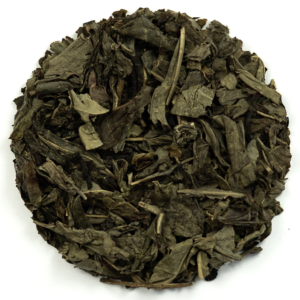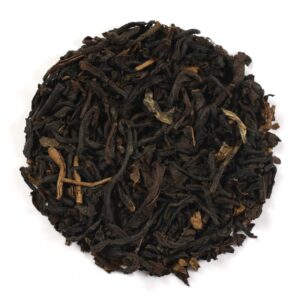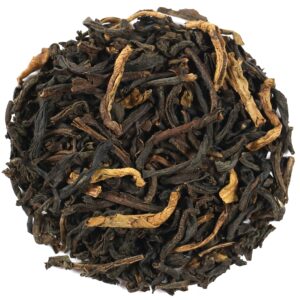Decaffeinated Tea
Decaffeinated Tea can be anything from Black to Green to White to Oolong. The term refers to the removal of caffeine from the leaves. Such a process makes Decaf Tea a suitable choice for caffeine-sensitive individuals and pregnant women, as well as anyone wanting to cut down.
You can buy Decaffeinated Tea online or in-store at The Kent and Sussex Tea and Coffee Company.
Showing all 10 results
-

Decaffeinated Darjeeling Tea TGFOP
From £4.45— or subscribe and save 10%Select options This product has multiple variants. The options may be chosen on the product page -
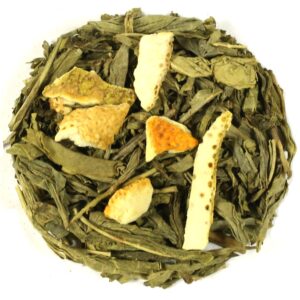
Decaffeinated Earl Grey Green Tea
From £3.82— or subscribe and save 10%Select options This product has multiple variants. The options may be chosen on the product page -
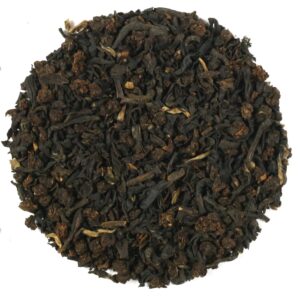
Decaffeinated English Breakfast Tea
From £4.05— or subscribe and save 10%Select options This product has multiple variants. The options may be chosen on the product page
How is Tea Decaffeinated?
A common misconception is that Decaf Loose Tea is 100% void of the stimulant. No type of Decaf Tea nor decaffeination method is that efficient, though some processes come close. There are four primary ways to extract caffeine, two of which we use here at The Kent and Sussex Tea and Coffee Company. The other two don’t meet our high standards. They are the following:
Methylene Chloride Process
This is the most widespread means of decaffeination in the industry. It involves a chemical called Methylene Chloride used as a solvent to extract the caffeine molecules. The result is the removal of around 96-97% of caffeine. However, while efficient, we don’t consider it especially safe and, therefore, steer clear of it.
Ethyl Acetate Process
This is a chemical found naturally in several fruits. Some people suggest that it is better than Methylene Chloride when applied as a solvent. The trouble is that, while organic, it still, in rare instances, leads to health complications. We again avoid it despite its ability to remove 96-97% of caffeine content from Tea and Coffee.
Carbon Dioxide (Co2) Process
This is the safest and most efficient method. It functions by using pressurised liquid Co2 to extract the small caffeine molecules. Best of all is the fact that the larger flavour molecules stay almost entirely intact. The process removes 96-98% of the stimulant, which is the highest amount you can expect from decaffeination.
Swiss Water Process
This phrase refers not to the origin of the water but where the method originates. What it does is use hot water to extract both the flavour and caffeine molecules. These then pass through a carbon filter, which removes the caffeine content while retaining the flavour molecules for “returning” later. It accounts for 94-96% of caffeine.
What Tea is Naturally Decaffeinated?
There are several types of Decaf Tea to buy and enjoy at home. However, you can expect any variety to have a residue amount of Caffeine in Tea, usually amounting to around 15 milligrams. This isn’t much, but you might well be wondering, “What Tea is naturally decaffeinated?” The best solution we could provide you with is a Herbal Tea, which, unless it is Yerba Mate, never had caffeine in the first place.
Is Decaffeinated Tea Good for You?
Another common misconception is that Decaffeinated Loose Leaf Tea lacks health benefits. It is true that the process of decaffeination likewise removes some antioxidants. But not all. Frequent consumption will still improve your life in small yet significant ways. This includes boosted immunity, improved digestion, enhanced cognitive function and a reduced risk of developing type-2 diabetes.
How to Brew Decaf Black Tea
You know what to expect from your morning cuppa. Now comes the time to learn how to brew it. The easiest way forward would be to choose Decaffeinated Black Tea Bags, which require little effort on your part. Alternatively, should you prefer Loose Tea, then you’ll need either a Tea Filter or Infuser. Once you have one of these items to hand, you can follow the instructions below:
1, Put Loose Tea in a Filter or Infuser.
2, Place the Tea-filled accessory in a cup.
3, Boil water and pour it over the Tea.
4, Allow it to steep for 3-5 minutes.
How to Serve: Consider having Milk or a Milk Alternative, sugar, honey or lemon.
How to Brew Decaffeinated Green Tea
Brewing Decaffeinated Green Tea can be a little more complicated. The temperature of the water, for starters, needs to be cooler; otherwise, you risk burning the leaves. How long you allow it to steep, too, will play a considerable role. Any longer than two or three minutes, and it might taste bitter. But providing you adhere to these rules, you’re in for a treat. Here is your step-by-step guide:
1, Put the Green Tea into a Tea Infuser or Filter.
2, Place the accessory in a mug or cup.
3, Boil fresh water and allow it to cool to temperatures between 80 and 90°C.
4, Infuse for 1 to 3 minutes.
How to Serve: Consider honey or lemon. The other option is to serve without accompaniments.

 Loose Leaf Tea
Loose Leaf Tea Pyramids
Pyramids Tea Bags
Tea Bags Africa
Africa Assam
Assam Ceylon
Ceylon Chinese
Chinese Darjeeling
Darjeeling European
European Indian
Indian Japan
Japan Nepal
Nepal South East Asia
South East Asia Ayurveda Tea
Ayurveda Tea Black Tea
Black Tea Chai Tea
Chai Tea Flowering Tea
Flowering Tea Fruit Tisanes
Fruit Tisanes Green Tea
Green Tea Herbal Tea
Herbal Tea Matcha Tea
Matcha Tea Oolong Tea
Oolong Tea Organic Tea
Organic Tea Pu erh Tea
Pu erh Tea Rooibos Tea
Rooibos Tea White Tea
White Tea Asian Coffee
Asian Coffee Caribbean Coffee
Caribbean Coffee Central American Coffee
Central American Coffee South American Coffee
South American Coffee Coffee Blends
Coffee Blends Decaffeinated Coffee
Decaffeinated Coffee Espresso Coffee
Espresso Coffee Ethically Sourced Coffee
Ethically Sourced Coffee Flavoured Coffee
Flavoured Coffee Organic Coffee
Organic Coffee Single Origin Coffee
Single Origin Coffee Chocolate 1
Chocolate 1 Chocolate 2
Chocolate 2 Chocolate 3
Chocolate 3 Chocolate 4
Chocolate 4 Chocolate 5
Chocolate 5 Chocolate 6
Chocolate 6 Chocolate 7
Chocolate 7 Chocolate 8
Chocolate 8 Chocolate 9
Chocolate 9 Loose Tea Filters
Loose Tea Filters Tea Accessories
Tea Accessories Tea Bricks
Tea Bricks Tea Caddies
Tea Caddies Tea Caddy Spoons
Tea Caddy Spoons Tea Gift Ideas
Tea Gift Ideas Tea Infusers
Tea Infusers Tea Strainers
Tea Strainers